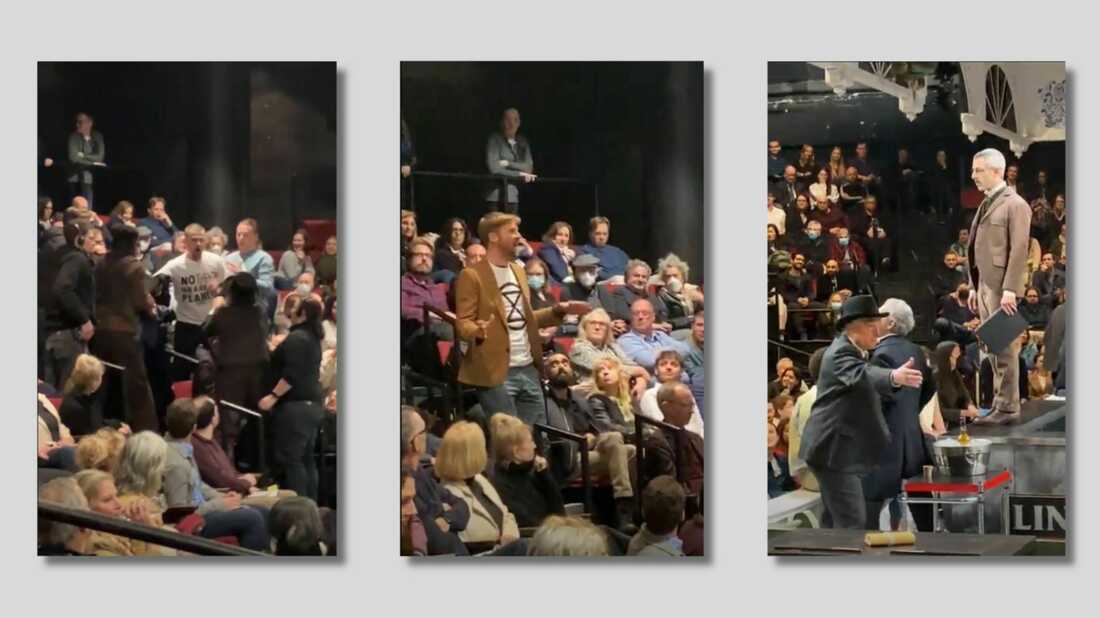Theater
‘We want to help’: Why climate activists are trying something new
‘We want to help’: Why climate activists are trying something new
Audio will be available later today.
Activists from Extinction Rebellion, left and center, protest during a performance of An Enemy of the People on Broadway, starring Jeremy Strong, right.
Extinction Rebellion NYC
hide caption
toggle caption
Extinction Rebellion NYC
Activists from Extinction Rebellion, left and center, protest during a performance of An Enemy of the People on Broadway, starring Jeremy Strong, right.
Extinction Rebellion NYC
There’s a scene in Henrik Ibsen’s 1882 drama An Enemy of the People that takes place at a public meeting. The residents of a spa town are trying to prevent a local doctor, Dr. Stockmann, from telling the truth about a factory that’s polluting the local water supply.
That’s the moment when, one recent evening, a climate activist stood up from his seat in the audience. It was during a press night for the current production running at Circle in the Square Theatre on Broadway.
“I object to the silencing of scientists!” said Nate Smith as he walked toward the stage wearing a T-shirt bearing the logo of Extinction Rebellion NYC. He was the first of three members of the climate change activism group to disrupt the show that night.
Security hustled the activists out, police officers showed up, and theater management asked the actors to clear the stage. But the actors stayed put and stayed in character. Many audience members believed the intrusion was part of the production.
That’s because the theme of the protest echoed the theme of the show.
“This is a play that speaks very much to the difficulty of getting truth out in a public square,” said Time Out New York theater editor and critic Adam Feldman, who was at the theater that night. “And specifically, truth about dangers to the environment.”
Later, actor Jeremy Strong, who stars as Dr. Stockmann, went on Late Night with Seth Meyers to talk about that moment.
“This is a play about trying to communicate an inconvenient truth to the power structure,” he said. “I’d be a hypocrite if I didn’t support what [the activists] were saying. It only underlies the message of the play.”
YouTube
A new approach
Climate change-related actions are ramping up in cultural spaces around the world. They’re shocking, so they get a lot of attention. Activists have flung mashed potatoes at a Monet painting in Germany and stormed the stage during a performance of Les Miserables in London’s West End, among many other art-focused disruptions.
These types of protests are meant to show how human-caused climate change will destroy the things people love — namely, art — unless we take action.
But these actions often spark outrage from social media and the public.
Even a recent study of mainstream media reactions to Last Generation, the German climate activism group behind many protests involving defacing works of art, shows that the overwhelming majority of articles were critical.
That’s why Extinction Rebellion wanted to try something different.
“If I’d just stood up and started shouting, ‘We’re in a climate crisis! There’s no theater on a dead planet!’ people would have booed immediately,” Smith said. “But if some people are like, ‘Is this a part of the play? This is what it’s about!’ you show that you’re not trying to be ‘an enemy of the people,’ like everybody wants to make you out to be. You’re really coming to try to help.”
In other words, instead of existing in opposition to the Broadway play, the protest was meant to blend in.
“This kind of tactical innovation is, I think, pretty necessary and important,” said James Özden, the founder of Social Change Lab, a nonprofit that researches climate activism and other social movements. “Because often things just stop being as effective over time as people become used to it. How do we reach new people? How do we keep pushing the agenda?”
And what the activists want is not just awareness — but also action.
“We have this problem in the theater, sometimes, of being accused of preaching to the choir. And I do think there’s always an aspect of that,” said Bess Rowen, an assistant professor of theater at Villanova University in Pennsylvania who studies theater activism, protests and scandals.
“But, there’s still an expectation of passivity — that we are aware of these things, but are we doing anything about them? And these days, if you’re paying for those Broadway tickets, maybe you’re not feeling the effects of climate change as specifically as other kinds of folks are. Because maybe it hasn’t impacted your everyday life in this kind of way.”
Time Out‘s Feldman said that’s exactly why this particular piece of climate change activism was so effective — especially when, in a moment of life imitating art — some members of the audience turned on the climate activists, much like the townspeople in Ibsen’s play shout down environmental whistle-blower Dr. Stockmann.
“It was fascinating to see how quickly this well-behaved, presumably relatively liberal, Broadway audience turned into this groupthink, this derision of the activists who were making their point,” Feldman said. “I’m not saying that I want to see this kind of thing at every show. But in this particular instance, it really felt perfect.”
What now?
A spokesperson for Extinction Rebellion New York said this action was among the group’s most successful so far, in terms of positive coverage. But he says it’s just one of many approaches the group is experimenting with in their ongoing effort to get people to do something about climate change.
Over the last couple of weeks, Extinction Rebellion members have popped up in spaces that have nothing to do with art. Among them was a more traditionally direct protest against the fossil fuel industry at the New York Auto Show: activists splashed oil on cars.
Audio and digital story edited by Jennifer Vanasco; audio produced by Isabella Gomez Sarmiento.
